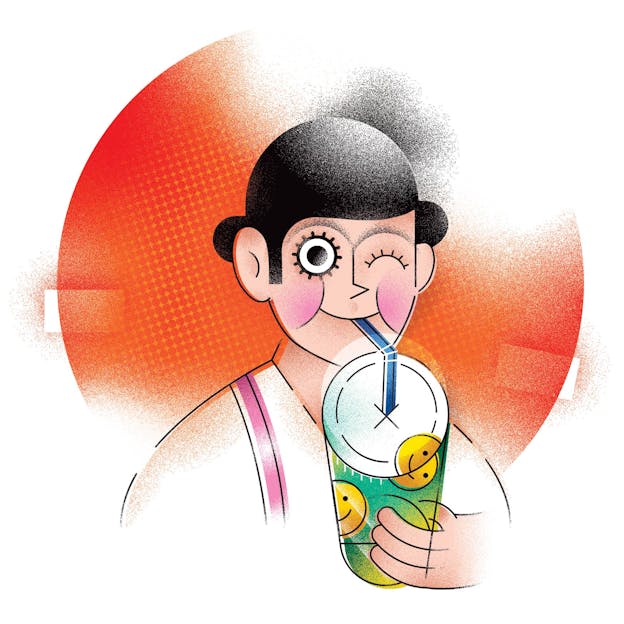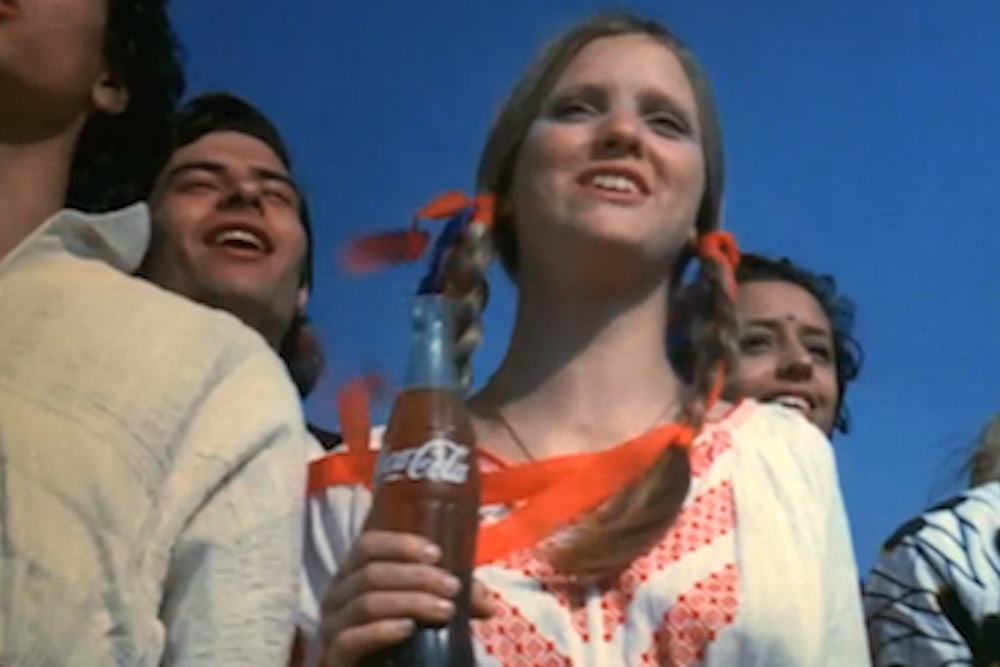“Drink what?” the woman with a big Coca-Cola logo on her red name badge asked Marion Nestle and me after giving us our warm-up talk in a large room with a floor-to-ceiling case of memorabilia—all the better to make you want to buy more memorabilia in the enormous gift shop where the visit debouches—that initiates you into the World of Coca-Cola. “The soda on your badge,” Nestle said. The blank look returned to a ready smile. She was one of several poised, enthusiastic young women of color—Coke prides itself on its diversity—who told us the closest they come to consuming the products they so brightly hawk is the occasional bottle of Dasani.
A part of any Atlanta initiate’s must-see list, the World of Coca-Cola is housed in a large, sunlit building on a superblock in the heart of downtown Atlanta whose style, like most of downtown, is windswept plaza-gulch, urban-renewal-hangover. I’d put off a visit until I lured Nestle, who spent three years working on a book about soda power both hard and soft, Soda Politics: Taking on Big Soda (and Winning), to plunge in with me.
We assumed, of course, that we would maintain our ironic distance. Wouldn’t you? Nestle devotes several chapters to soda hard power: lobbying, campaign contributions, front groups with innocuous names, crippling lawsuits. She recounts the startlingly successful co-opting of minority community groups. When New York City tried to institute a limit on portion sizes (not a “soda ban,” as Big Soda inaccurately and very effectively branded it), the industry told lower-income customers they were being patronized and bullied by the white elite, and mainstream African-American and Hispanic organizations came out against it. When San Francisco tried to pass a soda tax by ballot initiative, a $45,000 donation to the Harvey Milk LGBT Democratic Club helped buy its opposition. The New York Times recently recounted in merciless detail how much “objective” academic research funded by Coke somehow finds sugar-sweetened beverages to be weakly linked to the rise in obesity and diabetes, if linked at all. I’d read all that. You’ve probably read all that. Nestle wrote a 500-page book about it. But once immersed in the World of Coca-Cola, we were mesmerized, thrown back to a state of childlike wonder. After almost three hours, we didn’t want to leave.
The tour begins with resistible theme-park kitsch. A hokey video security scanner is the start of a spy-thriller chase for the secret formula, with visitors hampered by new electronic-watchdog checks at every step until they at last come to the blindingly lit Raiders of the Lost Ark-style vault that supposedly contains the only copy of the formula. “All over the internet,” Nestle sniffed, citing Mark Pendergrast’s definitive history, For God, Country, & Coca-Cola.
Resistance is futile, though, once you reach the movie theaters showing long loops of Coke commercials from across the decades and around the world. It’s something like A Clockwork Orange, except this viewing was voluntary. Remember how “I’d like to buy the world a Coke” went through your head for days as the annoyingly young and attractive models sing it in “Hilltop,” the 1971 ad that ended Mad Men? How you went online after the finale to watch the whole commercial and read about its creation? Well, that wasn’t the only one. Year after year, decade after decade, Coke was exquisitely attuned to the times, with attractive but not-too-soigné black young people on city stoops singing and frolicking on not-too-bombed-out city streets, like a black prequel to In the Heights. The many “Open Happiness” commercials become insinuatingly, irresistibly potent. There’s a reason Warren Buffett explains his $16 billion stake in Coke as a bet on the most successful branding in history.

Nestle, a matchlessly frank and clear writer, did not put in the years on her book because she thinks nothing can be done to fight Big Soda. She didn’t need to chronicle its dark side: Dozens of writers have done that, most authoritatively Pendergrast. Instead, she wrote Soda Politics as an advocacy manual—for any kind of advocacy, really. Chapters end with steps you can take to, say, eliminate sodas in schools or take soda off the Supplemental Nutrition Assistance Program (SNAP) eligibility list. The afterword’s author, Neal Baer, put his training as a pediatrician and producer and writer of ER and Under the Dome into a web site to accompany the book, actionlab.org. That site was funded, in turn, by the Robert Wood Johnson Foundation, whose head, Risa Lavizzo-Mourey, announced in February a commitment to end all sugar-sweetened beverage consumption in children under the age of five. All these people, and the author of the foreword, Mark Bittman, whose five-year columnist stint for The New York Times included constant targeting of sugar-sweetened beverages, believe that change is here.
Another believer, Tom Farley, New York City’s former health commissioner, tells the story of the soda ban—whoops! portion cap—in his new book, Saving Gotham: A Billionaire Mayor, Activist Doctors, and the Fight for Eight Million Lives, an inside look at life on the front lines of progressive public health. When Farley, supported by Mayor Michael Bloomberg, proposed the cap, he was blindsided by the instant “soda ban” tag, a New Yorker cover showing a brave young couple caught sharing a Big Gulp-sized soda in flagrante, and an industry front group’s clever campaign dressing the mayor as a finger-waving nanny. (Bloomberg’s clever reply: I would never wear that dress.) Farley is now working on anti-soda campaigns in Appalachia, taking inspiration from evidence that sales and consumption have gone down a year after Mexico passed a national soda tax with Bloomberg-funded lobbying.
Fighting hard power with taxes and regulation is one thing; soft power is another. You know that if your eyes are open, in the next few minutes you’ll be exposed to a Big Soda ad or message, however subliminally. But it isn’t just the incessant and overt marketing we think we can inure ourselves to and maybe can’t. Indirect marketing has likely reached your life, too. And I mean you. Like Big Tobacco, Big Soda has made pioneering and, Nestle would argue, unprecedented use of philanthropy—both foresighted and reactive—to buy goodwill and, most insidiously, silence. Whenever activists reach a community, or researchers look into the effects of sugar-sweetened beverages on health, Big Soda will be there, too—or get there fast.
Where does that leave the concerned reader? With Nestle’s specific, succinct steps throughout Soda Politics. With Baer’s attractively designed links and action steps on actionlab.org. And, if you’re like me, with a different and perhaps unrealistic form of optimism: that Big Soda can use its unparalleled reach and marketing skill as a force for good. Coca-Cola knows obesity is threatening its future. It’s the very first risk factor in its mandatory SEC filings: “Obesity concerns may reduce demand for some of our products.” Coca-Cola and PepsiCo will never do anything to further erode their already eroding sales in the core products that still account for their highest profits. But they know they must change. PepsiCo makes snack food and can—and I hope will—keep to its path of producing better-for-you snacks, rocky as that path has been with impatient investors. Coca-Cola is more boxed in. But it is constantly marketing new kinds of fortified and healthy-positioned beverages. It can devote more marketing muscle to those. It can push moderation, not just the dodge-and-feint of promoting exercise.
Turning Big Soda’s unparalleled marketing skills against itself has certainly been tried. But it’s harder to demonize soda than tobacco—which plain kills people, even in moderation. New York City, as Farley details, has tried, devising a campaign showing gross globules of fat sickeningly streaming out of soda bottles in its, “Are you pouring on the pounds?” campaign, and, anti-tobacco-ad style, showing amputees in posters for its portion-cap campaign. The Center for Science in the Public Interest parodied the “Hilltop” ad and, less clumsily, the frolicking polar bears.
But really, forget it. Fighting the feel-good message Nestle and I came out of the Coke commercials unwillingly infused with is an overwhelming task. Even my spouse, a longtime public health official, entered his World of Coca-Cola tour with eyes firmly rolling and left saying, “Gee, I think I want a T-shirt!” In the huge gift shop, I had to restrain Nestle from buying a $65 set of sheets patterned, Pop Art-style, with bold black drawings of Coke bottles. She did see what was happening: “They make us pay $16 for admission,” she said, “subject us to endless Coke ads, and then spend more money so we’ll be walking Coke ads.” The real thing that stopped her from buying the sheets was that they were polyester.
My own order of battle is to use Big Soda’s unparalleled marketing skill and budgets to help with public health campaigns, not subvert them. Why would a profit-seeking company do that? Public shaming, an inexorably declining market for drinks more and more people consider unhealthy, and the possibility that Mexico-style taxes could happen here despite their best efforts, for a start. Now, when the Times and everyone else is gleefully catching out Coke on its funding practices and reporting on the decadelong decline in soda sales—and when the leadership of Coca-Cola is, word in food-people circles has it, open to new ideas of all kinds, presumably ones that will help shore up its declining market share—is a good time to ask Big Soda to help. With the branding skill that penetrated Nestle’s and my unconscious—and for all I know changed mine permanently—you have to pray they will.
